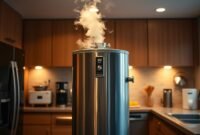Having trouble with your heating system? A low thermopile voltage can make your home cold and uncomfortable. Many people struggle with infrared sensor malfunctions that affect their gas appliances.
When your heat detection fails, it’s not just about being chilly. It’s a sign of a bigger problem that could be dangerous. Issues with thermal imaging can also make your system less effective, leaving you cold and worried about the cost of fixing it.
This guide will help you figure out and fix thermopile problems. We’ll cover how to spot voltage issues and do the right tests. You’ll learn how to handle these technical problems confidently.

Understanding Thermopile Basics and Function
Thermopiles are amazing devices that turn heat into electricity. They are key in many heating systems and for measuring temperature. Knowing how thermopiles work is vital when dealing with thermal camera issues.
Thermopiles work by changing temperature differences into voltage. They use many thermocouples in series. This makes them very sensitive and powerful.
How Thermopiles Generate Voltage
Understanding how thermopiles make voltage is important when they fail. They use the Seebeck effect to create electrical power from temperature differences. Key points include:
- Voltage output is directly related to temperature difference
- They don’t need an outside power source
- They can send signals without touching anything
Common Applications in Heating Systems
Thermopiles are vital in heating systems. A low voltage output can mean trouble in gas appliances like water heaters and fireplaces. Their main jobs are:
- Keeping gas burners safe
- Monitoring temperature in industrial gear
- Measuring temperature without touching
Read also: How to Flush a Gas Water Heater
Normal Operating Parameters
Knowing what a healthy thermopile does is key when it needs to be replaced. A good thermopile makes 500-750 millivolts. Watching these numbers helps avoid system failures and keeps things running smoothly.
Essential Tools for Thermopile Testing
Having the right tools is key when checking a faulty thermopile module. I’ll show you the must-haves for testing your gas control and pilot light.

To measure thermopile voltage accurately, you need a digital multimeter. It should be able to read millivolts. Choose a model made for low-voltage tests.
Read also: Why Pilot Light Keeps Going Out on Gas Furnace
Key Testing Tools
- Digital multimeter with millivolt setting
- Protective work gloves
- Safety glasses
- Needle-nose pliers
- Flashlight
When testing your thermopile, focus on these key voltage levels:
| Voltage Range | Diagnostic Interpretation |
|---|---|
| 650-850 millivolts | Normal operating range |
| 400-649 millivolts | Potential performance issues |
| Below 400 millivolts | Requires immediate professional inspection |
Professional tip: Make sure your pilot light has been on for two minutes before testing. Use the DC millivolt setting on your multimeter for the most accurate readings.
Testing Procedure Highlights
- Turn off the main power switch
- Locate the thermopile connections
- Connect multimeter leads
- Record voltage measurements
- Compare results to standard ranges
Knowing these basics will help you spot problems with your water heater’s thermopile module early. This can save you from expensive repairs later.
Locating Your Gas Control Valve and Thermopile
Knowing where your gas control valve and thermopile are is key for upkeep and fixing issues. These parts are vital for your heating system’s safety, like in water heaters and gas fireplaces.
Common Valve Locations
Let’s find your gas control valve. You’ll usually find these important parts in certain spots:
- Underneath the lower grill of a gas fireplace
- Accessible areas of water heaters
- Near the base of heating equipment
- Inside mechanical rooms or utility spaces
Identifying Thermopile Connections
The thermopile sensor is essential for making thermopile voltage. It has a unique wire setup:
- Wire running from pilot assembly to the control valve
- Protected by metal or tan fabric sheath
- Two primary wires (often red and white)
Wire Configuration Guide
When checking your gas control valve, look for specific terminals for thermopile connections:
- TP terminals (Thermopile)
- TP/TH terminals
- Ensure proper wire attachment for optimal performance
Recent rules stress the need to know these connections. LED indicators on gas control valves give vital info. They show specific flash codes for problems.
By knowing these spots and connections, you can better spot and fix issues with your thermopile and gas control valve.
How to Test Thermopile Voltage Low Conditions

Testing thermopile voltage is key to finding infrared sensor problems. Knowing how to test your device can save you time and avoid buying new ones.
To test thermopile voltage, you’ll need a few tools:
- Digital multimeter
- Safety gloves
- Manufacturer’s manual
Here are the steps to accurately measure voltage:
- Find the gas control valve terminals
- Put multimeter leads on TP and TP/TH terminals
- Make sure the pilot light is on for 2 minutes
- Keep the main switch off during the test
Voltage readings tell you a lot about thermopile health. A good thermopile should make 500 to 750 millivolts when the pilot flame is fully lit.
| Voltage Range | Condition | Recommended Action |
|---|---|---|
| 650-850 millivolts | Healthy Thermopile | No action required |
| 400-650 millivolts | Marginal Performance | Monitor closely |
| Below 300 millivolts | Critical Malfunction | Replace thermopile |
Look out for common problems like dirt, weak pilot flame, or wiring issues. Regular upkeep stops unexpected voltage drops and keeps your device running well.
Read also: Sensus Water Meter: The Most Common Problems
Understanding Voltage Readings and Specifications
Accurate voltage measurement is key when checking thermopile performance. It helps spot temperature measurement errors and heat detection failures. Knowing the voltage specs well can also stop thermal imaging problems in heating systems.
Normal Operating Ranges
Thermopile voltage usually stays within certain ranges for best performance. Most thermopiles work well between these values:
- Low-end thermopiles: 20-30 millivolts (mV)
- Standard thermopiles: 500-750 millivolts (mV)
- High-end thermopiles: Around 1000 mV or 1 volt
Critical Voltage Thresholds
Knowing the critical voltage levels is important for spotting system failures. Important voltage points include:
- Minimum pilot voltage: 325 millivolts with pilot on and main switch off
- Zero voltage when main switch activates: Possible short in thermopile
- No voltage change: Possible switch signaling problem
- Slight voltage drop: Possible main control valve issue
Interpreting Test Results
Understanding voltage readings well is essential. I suggest tracking voltage changes and comparing them to the specs. This helps find temperature measurement errors or heat detection failures.
When testing, use a good multimeter and keep measurement conditions the same. A careful method will help find thermal imaging issues and avoid system problems.
Common Causes of Thermopile Malfunction
When you face issues with your thermal camera or low voltage, knowing why thermopile circuits fail is key. I’ve found that several main factors can affect your thermopile’s work.
The most common problems that cause thermopile malfunctions include:
- Dirty or clogged pilot light mechanisms
- Weak pilot flame conditions
- Physical degradation of the thermopile
- Electrical connection problems
- Insufficient gas supply
About 1 in 125 water heaters face voltage issues. A dirty pilot light can block the thermopile’s voltage generation. Weak pilot flames often come from partially closed gas valves or air in the gas line.
Thermopile performance naturally gets worse over time. Tests show a healthy thermopile should read 650 to 850 millivolts in an open-circuit test. If it drops below 400 millivolts, it needs to be replaced.
Electrical connections are vital for thermopile work. Bad connections can stop current flow, leading to low voltage and system failures.
Knowing these common causes helps you spot and fix thermopile circuit failures early. This way, you can avoid bigger problems.
Troubleshooting Safety Switch and Snap Disc Issues
Gas-powered water heaters and heating systems have important safety features. These features, like safety switches and snap discs, keep your equipment and home safe from harm.
Understanding these safety parts is key when your thermopile module fails. They watch the temperature and stop it from getting too high.
Safety Switch Functions
Safety switches in gas appliances do several important jobs:
- They watch the temperature
- They stop gas flow when something’s wrong
- They help avoid fires
- They protect parts from getting too hot
Testing Procedures
When you need to replace the thermopile, testing the safety switches is vital. Here’s what to do:
- Turn off the power
- Find the safety switch near the gas valve
- Check the electrical connections
- Use a multimeter to check if the switch works
- Make sure it reacts to temperature changes
Common Failure Points
Spotting problems in safety switches can stop big issues with your water heater. Look out for these signs:
| Failure Type | Symptoms | Recommended Action |
|---|---|---|
| Electrical Disconnection | No continuity | Replace switch |
| Temperature Insensitivity | Fails to interrupt circuit | Professional inspection |
| Physical Damage | Visible wear or corrosion | Immediate replacement |
Always put safety first when working with gas appliances. If unsure, get a professional to check and fix it.
Thermopile Replacement Process
Replacing a thermopile needs careful steps. I’ll guide you through the process to replace your gas control valve’s key part safely and effectively.
Before starting, safety is the top priority. Here are the essential preparation steps:
- Turn off the gas supply completely
- Disconnect electrical connections
- Allow the system to cool down thoroughly
- Gather necessary tools: multimeter, wrench, replacement thermopile
When working with the pilot light and gas control valve, follow these critical guidelines:
- Carefully remove the main burner assembly
- Disconnect the existing thermopile from the gas control valve
- Inspect the pilot assembly for any visible damage
- Install the new thermopile with precise positioning
During installation, avoid sharp bends or twists in the thermopile’s capillary tubing. Improper handling can damage the sensitive component and affect thermopile voltage performance.
After installation, perform a thorough voltage test. A properly functioning thermopile should generate between 350mV and 850mV. Any reading below 350mV indicates a problem that needs further investigation or professional help.
Pro tip: If you’re unsure about any step in the replacement process, it’s best to consult a certified technician. They can ensure proper installation and help diagnose any issues with your gas control system.
Conclusion
Understanding your gas control valve and thermopile is key to safe and efficient heating. Thermopile troubleshooting needs patience, precision, and a careful approach. This helps spot voltage issues.
Most thermopile problems come from simple causes like loose connections or temperature changes. If voltage drops below 400 millivolts, you might need a pro. Regular checks and maintenance can stop many issues with your gas control valve.
While you can fix some problems yourself, safety comes first. Damaged thermopiles need to be replaced, not fixed. If you’re not sure about anything, getting a professional is the best choice. This ensures your heating system works well and safely.
Learning how to troubleshoot thermopiles helps you catch and fix problems early. This keeps your gas appliances working well and reliably.


